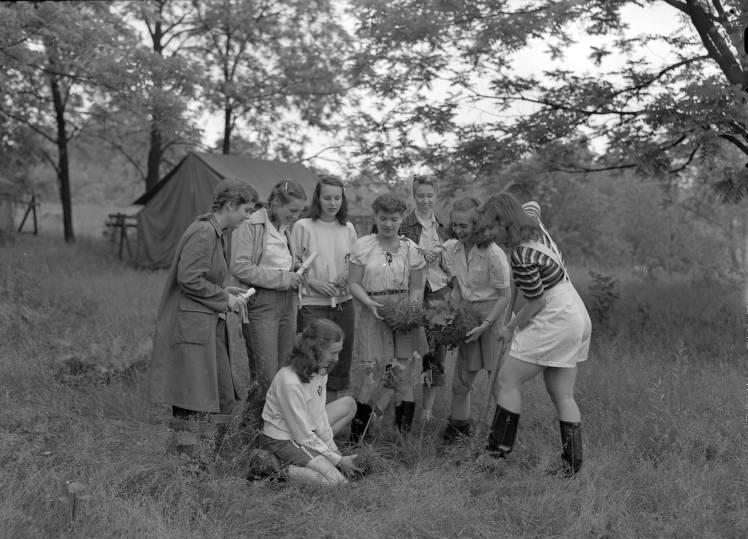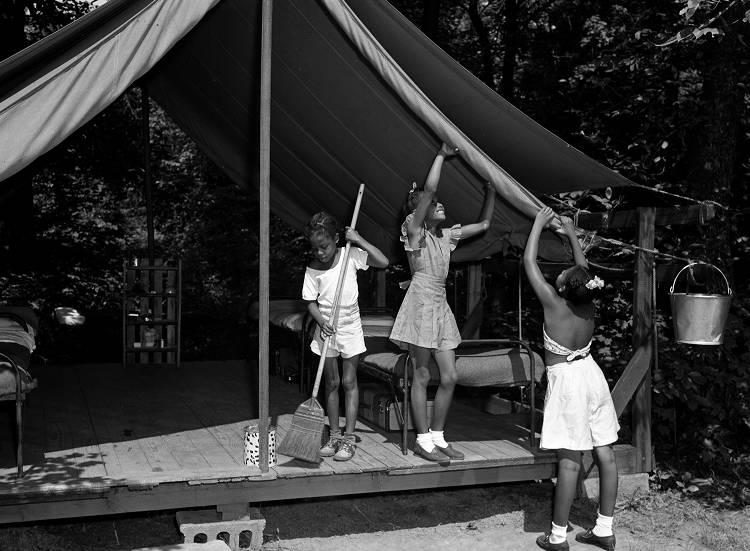Anna Marie Ridge established the first local troop on July 27, 1917, in after corresponding with Juliette Low, national founder of Girl Scouts. With nine troops in Indianapolis by 1919, the Indianapolis Leaders Association was established to offer support and training for adults.
The formal organization of a council, Girl Scouts, Inc., came in 1921. In the same year, Selma Harry organized the first African American troop with 20 girls from School 17. In 1922, girls could go camping at Camp Ada-Boy-Holliday along Williams Creek at College Avenue and 75th Street. The scouts soon outgrew this site, and Dorothy Dell Moffet donated land on the westside of Indianapolis along Eagle Creek. Camp Dellwood opened in the summer of 1926. That year also marked the formation of troops at the .

Cookies were sold for the first time in 1926, and the council made a profit of almost $700. The council hosted the National Girl Scout Conference in 1930. Scouts received title to what became known as the “Little House” on April 15, 1935, after meeting the challenge of getting 75,000 people to visit the structure (a home remodeled by the Construction League in conjunction with the Better Housing Program) in less than four months.
During World War II, Girl Scouts baked cookies for the Serviceman’s Center, participated in war bond drives, and demonstrated cooking meatless meals on the Circle. By 1952, there were 8,000 scouts in Marion County.
March 5, 1958, marked the formation of the Hoosier Capital Girl Scout Council (HCGSC). With 950 troops and 14,385 members, the new council included scouts in Boone, Hamilton, Hancock, Hendricks, and Marion counties. In 1960, Girl Scouts United States of America, Inc. added Johnson, Shelby, and the northern half of Morgan county to HCGSC. Dudley R. Gallahue donated 400 acres in Brown County to establish Camp Gallahue, which opened in the summer of 1961. The acquisition of Hawthorne Trails in Boone County (1962) and Camp Ada (1971) provided additional camping sites for the growing council.

Beginning in 1965, the Special Area Services project, funded by grants from , the , and , brought scouting to areas not traditionally served by regular troops. In 1967, the council sponsored a Senior Scout national conference on the inner city and the future of youth. The World of the Arts was an international event offered by the council in 1970.
During the 1980s, the council stressed career exploration and community service to the membership. In 1983, HCGSC sponsored an international workshop, called Arts in Action, which explored career opportunities in the arts. Cookie sales topped one million boxes in 1986, with the profits going into camping and assistance programs. In 1990, the Girls at Risk program targeted girls who had been brought into the juvenile court system and placed them in special troops to provide positive peer support. On the eve of the 75th anniversary of Girl Scouting in Indianapolis, the HCGSC had over 18,000 members.
A new organizational structure in 2007 made better use of resources and created more opportunities for girls. Several of Indiana’s councils were merged including Girl Scouts of Hoosier Capital Council, Covered Bridge Girl Scout Council, Girl Scouts of Treaty Line Council, Girl Scouts of Sycamore Council, and Girl Scouts of Wapephani Council, as well as the addition of Howard and Carroll Counties from Girl Scouts of Tribal Trails Council. This new merger became the Girl Scouts of Central Indiana, with headquarters in Indianapolis.
In October 2017, the announced it would soon allow girls to join its organization. They initiated an ad campaign to promote co-ed scouting called “Scout Me In” and changed the name of its main scouting program to Scouts BSA. The decision received considerable pushback at the national level from the Girl Scouts of the USA. In 2018 its leaders filed suit against the Boy Scouts of America asserting its use of the term “scout” and “scouting” violated the Girl Scouts’ trademark, created confusion among both boy scouts and girl scouts, and marginalized the female group. The Girl Scouts of the USA also claimed that only Girl Scout leaders had the expertise to give girls and young women the tools needed for success. To be clear, the Girl Scouts of Central Indiana took no part in the litigation between the two national-level organizations. Friction between the two organizations dates to the 1920s when the Boy Scouts sued the Girl Scouts over the name “scout.” Despite the pending litigation, the Boy Scouts rolled out its inclusion of girls at the Cub Scout level with the ability to earn the rank of Eagle Scout in 2019. One hundred years later as the Boy Scouts have been losing membership, it has aimed recruitment at girls to bolster membership rolls.
By 2019, Girl Scouts of Central Indiana had served over 36,000 girls in 45 counties. The organization also earned over $2 million in cookie sales and provided over $312,000 in financial assistance to help more girls participate. New badges focusing on modern issues were added yearly, and girls were taught through four program pillars: STEM education, outdoors, life skills, and entrepreneurship. Due to the social distancing required by the global pandemic (COVID-19) in 2020, Central Indiana’s girl scouts offered cookies via online sales for the first time in their history.
In April 2022 the Boy Scouts of America and the Girl Scouts of America agreed to settle their trademark dispute from 2018 over the Boy Scouts’ right to use the word “scouting” to advertise co-ed programs. A federal court in New York ruled that the Boy Scout organization’s use of the word “scouting” did not violate the Girl Scouts’ trademark. Despite this loss, the Girl Scouts of America celebrated receiving an $84.5 million donation from the MacKenzie Scott Foundation in October 2022. The Girl Scouts of Central Indiana received $2.4 million of those funds, representing one of the largest unrestricted donations ever received from an individual donor in the history of the organization.

Help improve this entry
Contribute information, offer corrections, suggest images.
You can also recommend new entries related to this topic.